Giorgio Napolitano facts for kids
Quick facts for kids
Giorgio Napolitano
|
|||||||||||||||||||||||||||||||||||
|---|---|---|---|---|---|---|---|---|---|---|---|---|---|---|---|---|---|---|---|---|---|---|---|---|---|---|---|---|---|---|---|---|---|---|---|
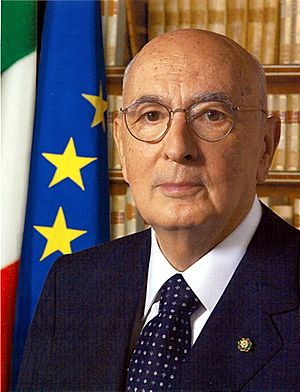
Official portrait, 2006
|
|||||||||||||||||||||||||||||||||||
| President of Italy | |||||||||||||||||||||||||||||||||||
| In office 15 May 2006 – 14 January 2015 |
|||||||||||||||||||||||||||||||||||
| Prime Minister | |||||||||||||||||||||||||||||||||||
| Preceded by | Carlo Azeglio Ciampi | ||||||||||||||||||||||||||||||||||
| Succeeded by | Sergio Mattarella | ||||||||||||||||||||||||||||||||||
| President of the Chamber of Deputies | |||||||||||||||||||||||||||||||||||
| In office 3 June 1992 – 14 April 1994 |
|||||||||||||||||||||||||||||||||||
| Preceded by | Oscar Luigi Scalfaro | ||||||||||||||||||||||||||||||||||
| Succeeded by | Irene Pivetti | ||||||||||||||||||||||||||||||||||
| Minister of the Interior | |||||||||||||||||||||||||||||||||||
| In office 18 May 1996 – 21 October 1998 |
|||||||||||||||||||||||||||||||||||
| Prime Minister | Romano Prodi | ||||||||||||||||||||||||||||||||||
| Preceded by | Giovanni Rinaldo Coronas | ||||||||||||||||||||||||||||||||||
| Succeeded by | Rosa Russo Iervolino | ||||||||||||||||||||||||||||||||||
|
|||||||||||||||||||||||||||||||||||
| Personal details | |||||||||||||||||||||||||||||||||||
| Born | 29 June 1925 Naples, Kingdom of Italy |
||||||||||||||||||||||||||||||||||
| Died | 22 September 2023 (aged 98) Rome, Italy |
||||||||||||||||||||||||||||||||||
| Political party | Independent (2006-2023) | ||||||||||||||||||||||||||||||||||
| Other political affiliations |
|
||||||||||||||||||||||||||||||||||
| Spouse |
Clio Maria Bittoni
(m. 1959) |
||||||||||||||||||||||||||||||||||
| Children | 2 | ||||||||||||||||||||||||||||||||||
| Alma mater | University of Naples Federico II | ||||||||||||||||||||||||||||||||||
| Signature | |||||||||||||||||||||||||||||||||||
Giorgio Napolitano ( 29 June 1925 – 22 September 2023) was an Italian politician who served as the president of Italy from 2006 to 2015, the first to be re-elected to the office. Due to his dominant position in Italian politics, some critics have sometimes referred to him as Re Giorgio ("King Giorgio"). In office from 2006 to 2015, he is the and longest-lived president in the history of the Italian Republic, which has been in existence since 1946. Although he was a prominent figure of the First Italian Republic, he did not take part in the Constituent Assembly of Italy that drafted the Italian constitution; and is considered one of the symbols of the Second Italian Republic, which came about after the Tangentopoli scandal of the 1990s.
Napolitano was a longtime member of the Italian Communist Party, which he joined in 1945 after taking part in the Italian resistance movement, and of its post-Communist democratic socialist and social democratic successors, from the Democratic Party of the Left to the Democrats of the Left. He was a leading member of migliorismo, a reformist, moderate, and modernizing faction on the right-wing of the PCI, which was inspired by the values of democratic socialism, looked favourably to social democracy, and was interested in revisionist Marxism. First elected to the Chamber of Deputies in 1953, he took an assiduous interest in parliamentary life and was president of the Chamber of Deputies from 1992 to 1994. He was Minister of the Interior from 1996 to 1998 during the first Prodi government. He was also the first high-ranking leader of a Communist party to visit the United States, which he did in 1978.
Napolitano was appointed a senator for life in 2005 by then president Carlo Azeglio Ciampi. In the May 2006 Italian presidential election, he was elected by the Italian Parliament as President of Italy. Napolitano was the first former Communist to become president of Italy. During his first term of office, he oversaw governments both of the centre-left coalition, such as the second Prodi government, and the centre-right coalition, such as the fourth Berlusconi government. In November 2011, Silvio Berlusconi resigned as prime minister of Italy amid financial and economic problems. In keeping with his constitutional role, Napolitano then asked former European commissioner Mario Monti to form a cabinet, which was referred to as a "government of the president" by critics.
When his seven-year presidential term expired, Napolitano (then aged 87) reluctantly accepted the results of the April 2013 Italian presidential election, becoming the first president of Italy to serve a second term, to safeguard the continuity of the country's institutions during the parliamentary deadlock that followed the February 2013 Italian general election. On being re-elected as president with broad cross-party support in Parliament, he overcame the impasse by inviting Enrico Letta to propose a grand coalition government. When Letta handed in his resignation on 14 February 2014, Napolitano mandated Matteo Renzi (Letta's factional challenger) to form a new government. After a record eight and a half years as president, citing age factors, the 89 years-old Napolitano resigned in January 2015; he then resumed his Italian Senate seat, which he held until his death in 2023.
Napolitano was often accused by his critics of having transformed a largely ceremonial role into a political and executive one, becoming during the years of his tenure the real kingmaker of Italian politics. Supporters credited him with saving Italy from the brink of default during the European debt crisis and subsequent political stalemates, which helped to stabilize the country. At the time of his death in 2023, Napolitano was the only living former Italian president, as well as the longest-lived president on record.
Contents
Early life
Napolitano was born in Naples, Campania, in 1925. His father Giovanni was a liberal lawyer and poet, while his mother was Carolina Bobbio, a descendant of a noble Piedmontese family. From 1938 to 1941, he studied at the Classical Lyceum Umberto I of Naples. In 1941, his family moved to Padua and he was graduated to the lyceum Titus Livius. In 1942, he matriculated at the University of Naples Federico II, studying law. During this period, Napolitano adhered to the local University Fascist Youth (Gioventù Universitaria Fascista), where he met his core group of friends, who shared his opposition to Italian fascism. As he would later state, the group "was in fact a true breeding ground of anti-fascist intellectual energies, disguised and to a certain extent tolerated".
An enthusiast of the theatre since secondary school, during his university years he contributed a theatrical review to the IX Maggio weekly magazine and had small parts in plays organized by the Gioventù Universitaria Fascista itself. He played in a comedy by Salvatore Di Giacomo at Teatro Mercadante in Naples. Napolitano dreamt of being an actor and spent his early years performing in several productions at the Teatro Mercadante.
Napolitano has often been cited as the author of a collection of sonnets in Neapolitan dialect published under a pseudonym, Tommaso Pignatelli, and entitled Pe cupià 'o chiarfo ("To Mimic the Downpour"). He denied this in 1997 and on the occasion of his presidential election, when his staff described the attribution of authorship to Napolitano as a "journalistic myth". He published his first acknowledged book, entitled Movimento Operaio e Industria di Stato ("Workers' Movement and State Industry"), in 1962.
World War II
During the existence of the Italian Social Republic (1943–1945), a puppet state of Nazi Germany in the final period of World War II, Napolitano and his circle of friends took part in several actions of the Italian resistance movement against German and Italian fascist forces.
Early political career
From post-war years to the Hungarian Revolution of 1956
In 1944, along with the group of Neapolitan communists, as Mario Palermo and Maurizio Valenzi, Napolitano prepared the arrival in Naples of Palmiro Togliatti, the long-time leader of the Italian Communist Party (PCI) who was in exile since 1926 when the Communist Party of Italy (PCd'I) was banned by the Fascist regime in Italy, and Togliatti was one of few leaders not to be arrested, as he was attending a meeting of the Comintern in Moscow. In 1945, he joined the PCI.
Following the end of the war in 1945, Napolitano became the PCI's federal secretary for Naples and Caserta. In 1947, he graduated in jurisprudence with a final dissertation on political economy, entitled Il mancato sviluppo industriale del Mezzogiorno dopo l'unità e la legge speciale per Napoli del 1904 ("The Lack of Industrial Development in the Mezzogiorno following the Unification of Italy and the Special Law of 1904 for Naples"). He became a member of the Secretariat of the Italian Economic Centre for Southern Italy in 1946, which was represented by Giuseppe Paratore, where he remained for two years. Napolitano played a major role in the Movement for the Rebirth of Southern Italy for over ten years.
In the 1953 Italian general election, Napolitano was first elected to the Chamber of Deputies for the electoral district of Naples. Apart from the 1963 Italian general election, when he did not sought re-election because he was the secretary of the Naples federation, a position he held from 1962 to 1966, he was always re-elected up to the 1996 Italian general election. He was elected to the National Committee of the party during its eighth national congress in 1956, largely thanks to the support offered by Togliatti, who wanted to involve younger politicians in the central direction of the party. He became responsible for the commission for Southern Italy within the National Committee.
In 1953, a document of the Italian Ministry of the Interior reported Napolitano as a member of the secret armed paramilitary groups of the PCI in the city of Rome, what became known as Gladio Rossa. Later on in the same year, the Hungarian Revolution of 1956 and its military suppression by the Soviet Union (USSR) occurred. The leadership of the PCI labelled the insurgents as counter-revolutionaries, and the official party newspaper L'Unità referred to them as "thugs" and "despicable agents provocateurs". Napolitano complied with the party-sponsored position on this matter, a choice he would repeatedly declare to have become uncomfortable with, developing what his autobiography describes as a "grievous self-critical torment". He would reason that his compliance was motivated by concerns about the role of the PCI as "inseparable from the fates of the socialist forces guided by the USSR" as opposed to imperialist forces.
The decision to support the Soviets against the Hungarian revolutionaries generated a split in the PCI and the CGIL (Italy's largest trade union, then supportive of the PCI) refused to conform to the party-sponsored position and applauded the revolution, on the basis that the eighth national congress of the PCI had stated that the "Italian Way to Socialism" was to be democratic and specific to the nation. These views were supported in the party by Giorgio Amendola, whom Napolitano would always look up to as a teacher. Frequently seen together, Amendola and Napolitano would jokingly be referred to by friends as respectively Giorgio 'o chiatto and Giorgio 'o sicco ("Giorgio the Pudgy" and "Giorgio the Slim" in the Neapolitan dialect).
Leading member of the Italian Communist Party
From the 1960s to 1980s
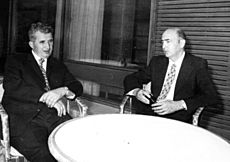
Between 1963 and 1966, Napolitano was party chairman in the city of Naples and later, between 1966 and 1969, he was appointed as chairman of the secretary's office and of the political office. In 1964, following the death of Togliatti, Napolitano was one of the main leaders who supported an alliance with the Italian Socialist Party, which after the end of the Popular Democratic Front joined the government with Christian Democracy. During the 1970s and 1980s, Napolitano was in charge for cultural activities, economic policy, and the international relations of the party.
Napolitano's political thought was somewhat moderate in the context of the PCI; he became the leader of the wing of the party called migliorismo, whose members notably included Gerardo Chiaromonte and Emanuele Macaluso. The term migliorista (from migliore, Italian for "better") was coined with a slightly mocking intent. To be a betterist was regarded more negatively than to be a reformist by traditional Communists.
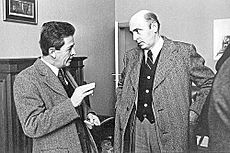
In the mid-1970s, Napolitano was invited by the Massachusetts Institute of Technology to give a lecture, but the United States ambassador to Italy, John A. Volpe, refused to grant Napolitano a visa on account of his membership of the PCI. Between 1977 and 1981 Napolitano had some secret meetings with the United States ambassador Richard Gardner, at a time when the PCI was seeking contact with the US administration, in the context of its definitive break with its past relationship with the Communist Party of the Soviet Union and the beginning of Eurocommunism, the attempt to develop a theory and practice more adapted to the democratic countries of Western Europe. He was an active member of the party until it ended in 1991. In 2006, when Napolitano was elected president of the Italian Republic, Gardner stated to the Associated Press Television News that he considered Napolitano "a real statesman", "a true believer in democracy", and "a friend of the United States [who] will carry out his office with impartiality and fairness".
Thanks to this role and in part by the good offices of Giulio Andreotti, in the 1980s Napolitano was able to travel to the United States and give lectures at Aspen, Colorado and at Harvard University. He has since visited and lectured in the United States several times. After the death of Enrico Berlinguer in 1984, Napolitano was among the possible successors as secretary of the party; Alessandro Natta was elected instead. In July 1989, Napolitano became Foreign Minister in the PCI shadow government, from which he resigned the day after the Congress of Rimini, where the PCI was dissolved. That same year, Napolitano supported the motion that led to the PCI's transformation and name change.
After the Italian Communist Party
After the dissolution of the PCI in February 1991, Napolitano followed most of its membership into the Democratic Party of the Left, a democratic socialist and social democratic party, which is considered the post-Communist evolution of the PCI.
President of the Chamber of Deputies
In 1992, he was elected president of the Chamber of Deputies, replacing Oscar Luigi Scalfaro, who became president of the Italian Republic. That legislature was hit by Tangentopoli and his presidency became one of the fronts of the relationship between the judiciary and politics.
Late 1990s and early 2000s
After the 1996 Italian general election, the Italian centre-left Prime Pinister Romano Prodi selected him as Minister of the Interior. He was the first former Communist to hold the office, a role traditionally occupied by Christian Democrats. In this capacity, he took part, together with fellow lawmaker and cabinet minister Livia Turco, in drafting the government-sponsored law on immigration control (Legislative Decree No. 40 6 March 1998), better known as the Turco–Napolitano bill. Napolitano remained Minister of the Interior until October 1998, when Prodi's government lost its majority in the Parliament.
Napolitano also served a second term as a member of the European Parliament from 1999 to 2004 within the Party of European Socialists. In October 2005, he was named senator for life, and was one of the last two to be appointed by Carlo Azeglio Ciampi, the then Italian president of the Republic, together with Sergio Pininfarina.
President of Italy
First term (2006–2013)
Election
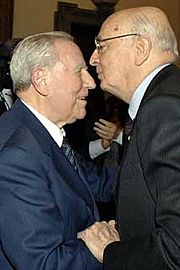
The 2006 Italian general election saw a victory of Prodi, Italy's centre-left coalition candidate, against the incumbent Italian centre-right Prime Minister Silvio Berlusconi. After the election, the presidents of both houses of parliament were chosen by the winning centre-left coalition, and so the centre-right House of Freedoms demanded an impartial candidate for the role of president of the Republic. The Union stressed the fact that the Italian constitution demands that the president be a defender of the constitution, hinting that such a quality was scarce among the opposition members.
Berlusconi was the most vocal opponent of any candidate that came from the PCI, in line with the anti-communist stance he had taken in the campaign. His allies, especially the Union of Christian and Centre Democrats (UDC), openly disagreed with his intransigence but vowed to stick with their ally's decision. When Napolitano was elected, Silvio Berlusconi gave an interview to one of his political magazines Panorama saying that the UDC betrayed him by letting 60 of his electors cast a blank vote on the first ballot, instead of supporting the official candidate Gianni Letta. When the UDC argued that this might have spelt the end of the coalition, Berlusconi changed his stance by saying that he had been misunderstood and that he never gave that journalist an interview.
The candidacy of Massimo D'Alema was supported by Napolitano's party, the Democrats of the Left, and by other parties of the coalition, such as the Party of Italian Communists, the Communist Refoundation Party, and Democracy is Freedom – The Daisy; it was opposed by others, such as the Rose in the Fist, arguing that his candidacy was driven by a particracy's mentality. Part of the more left-wing coalition considered D'Alema far too willing to conduct backroom deals with the opposition. Some moderate journalists liked D'Alema because his presidency would have given Prodi a stable government since the biggest party of the Union had not been rewarded with any institutional position.
In the opposition coalition, while Berlusconi vehemently opposed a D'Alema presidency, some of his aides, such as Marcello Dell'Utri, and some right-leaning newspapers, such as Il Foglio, campaigned for D'Alema. The official stance of the centre-right was that D'Alema, being an important left-wing politician and having participated in the election campaign, was ill-suited for president, a role that it is supposed to be impartial. When the Union proposed Napolitano, the House of Freedom objected that the Union should have presented a list of names. Even though Napolitano appeared at first a candidate that the House of Freedoms could converge on, the proposal was rejected much like that of D'Alema.
On 7 May, the centre-left majority coalition officially endorsed Napolitano as its candidate in the 2006 Italian presidential election, which began on 8 May. The Holy See endorsed him as president through its official newspaper, L'Osservatore Romano, just after the Union named him as its candidate, as did Marco Follini, former secretary of the UDC, a member party of the House of Freedoms. Napolitano was elected on 10 May in the fourth round of voting — the first of those requiring only an absolute majority, unlike the first three which required two-thirds of the votes — with 543 votes (out of a possible 1,009). At the age of 80, he became the first former Communist to become president of Italy, as well as the third Neapolitan after Enrico De Nicola and Giovanni Leone. He came out of retirement to accept.
After Napolitano's election, expressions of esteem toward him personally as regarding his authoritative character as the future president of the Italian Republic were made by both members of the Union and of the House of Freedoms, which had turned in blank votes, such as Pier Ferdinando Casini. Nevertheless, some Italian right-wing newspapers, such as il Giornale, expressed concerns about his Communist past. He started his term on 15 May.
Prodi Cabinet
On 9 July 2006, Napolitano was present at the FIFA World Cup final, in which the Italian national football team defeated France and won its fourth World Cup, and afterwards he joined the players' celebrations. He is the second president of the Italian Republic to be present at a FIFA World Cup final won by the Italian team after Sandro Pertini in 1982. On 26 September 2006, Napolitano made an official visit to Budapest, Hungary, where he paid tribute to the fallen in the 1956 revolution, which he initially opposed as member of the PCI, by laying a wreath at Imre Nagy's grave.
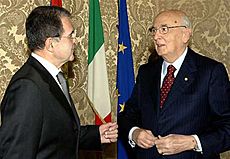
On 10 February 2007, a diplomatic crisis arose between Italy and Croatia after Napolitano made an official speech during the celebration of the National Memorial Day of the Exiles and Foibe. In the speech, he stated:
... Already in the unleashing of the first wave of blind and extreme violence in those lands, in the autumn of 1943, summary and tumultuous justicialism, nationalist paroxysm, social retaliation and a plan to eradicate Italian presence intertwined in what was, and ceased to be, the Julian March. There was, therefore, a movement of hate and bloodthirsty fury, and a Slavic annexationist design, which prevailed above all in the peace treaty of 1947, and assumed the sinister shape of "ethnic cleansing". What we can say for sure is that what was consumed – in the most evident way through the inhuman ferocity of the foibe – was one of the barbarities of the past century.
The European Commission did not comment on this event but partly condemned the response by Croatian president Stjepan Mesić, who described Napolitano's statement as racist because Napolitano did not refer to either Slovenians or Croatians as a nation when he spoke about a "Slavic annexationist design" for the Julian March; at the time, Slovenians and Croatians fought together with the Yugoslav Partisans. Another matter of debate in Croatia was that Napolitano made awards to relatives of 25 foibe victims, who included the last fascist Italian prefect in Zadar, Vincenzo Serrentino, who was sentenced to death in 1947 in Šibenik. That was seen by Mesić as "historic revisionism" and open support for revanchism. Napolitano's remarks on the foibe massacres were praised by both centre-left and centre-right in Italy, and both coalitions condemned Mesić's statements, while the whole of Croatia stood by Mesić, who later acknowledged that Napolitano did not want to put in discussion the Peace Treaty of 1947.
On 21 February 2007, Prodi submitted his resignation after losing a foreign policy vote in the Italian Parliament; Napolitano held talks with the political groups in parliament, and rejected the resignation on 24 February, prompting Prodi to ask for a new vote of confidence. Prodi won the vote in the upper house on 28 February, and in the lower house on 2 March, allowing his cabinet to remain in office.
2008 political crisis
On 24 January 2008, Prodi lost a vote of confidence in the Senate of the Republic by a vote of 161 to 156 votes, after the Union of Democrats for Europe ended its support for the Prodi-led government. On 30 January, Napolitano appointed the president of the Senate Franco Marini to try to form a caretaker government with the goal of changing the current electoral system rather than call a quick election. The state of the Italian electoral law of 2005 had been under criticism not only within the outgoing government but also among the opposition and in the general population because of the impossibility to choose candidates directly and of the risks that a close-call election might not grant a stable majority in the Senate.
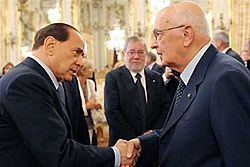
After Marini was given the mandate, Bruno Tabacci and Mario Baccini splintered from the Union of Christian and Centre Democrats to form the White Rose, while two leading members of the Forza Italia faction Liberal-Popular Union (Ferdinando Adornato and Angelo Sanza) switched allegiance to the UDC. On 4 February, the Liberal Populars (a UDC faction that favoured merging with Forza Italia) seceded from UDC to join Berlusconi's People of Freedom later this year. On 4 February, Marini acknowledged that he had failed to find the necessary majority for an interim government, and resigned his mandate, after having met with all major political forces and having found opposition to forming an interim government mainly from centre-right coalition parties Forza Italia and National Alliance, favoured in a possible next election and strongly in favour of an early vote.
Napolitano summoned Fausto Bertinotti and Marini, the two speakers of the houses of the Italian Parliament, acknowledging the end of the legislature on 5 February . He dissolved the Italian Parliament on 6 February. The ensuing snap election was held on 13 and 14 April 2008, together with the administrative elections. The elections resulted in a decisive victory for Berlusconi's centre-right coalition. On 7 May, Napolitano appointed Berlusconi as Prime Minister of Italy following his landslide victory in the 2008 Italian general election. The cabinet was officially inaugurated one day later, with Berlusconi thus becoming the second Prime Minister under Napolitano.
Eluana Englaro incident
On 6 February 2009, Napolitano refused to sign an emergency decree made by the Berlusconi government in order to suspend a final court sentence allowing suspension of nutrition to 38-year-old coma patient Eluana Englaro; the decree could not be enacted by Berlusconi. This caused a major political debate within Italy regarding the relationship between the President and the government in office.
2011 political crisis
On 11 October 2011, the Chamber of Deputies rejected the law on the budget of the State proposed by the government. As a result of this event, Berlusconi moved for a confidence vote in the Chamber of Deputies on 14 October; he won the vote with just 316 votes to 310, the minimum required to retain a majority. An increasing number of deputies continued to cross the floor and join the opposition. On 8 November, the Chamber of Deputies approved the law on the budget of the state that was previously rejected but with only 308 votes, while opposition parties did not participate in the vote to highlight that Berlusconi had lost his majority.
After the vote, Berlusconi announced his resignation after Parliament passed economic reforms. On 12 November, after a final meeting with his cabinet, Berlusconi met Napolitano at the Quirinal Palace to tend his resignation. As he arrived at the presidential residence, a hostile crowd gathered with banners shouting insults at Berlusconi and throwing coins at the car. After his resignation, the booing and jeering continued as he left in his convoy, with the public shouting words such as "buffoon", "dictator", and "mafioso".
Following Berlusconi's resignation, Napolitano then decided to appoint former European Commissioner Mario Monti as a senator for Life, and then as Prime Minister-designate. The Monti Cabinet was subsequently confirmed by an overwhelming majority of both houses of the Italian Parliament in what was widely referred to as a "government of the President". Napolitano's management of the events led to widespread international attention in his capacity as president, a role normally regarded as largely ceremonial. He received complimentary calls from multiple world leaders.
Second term (2013–2015)
Re-election

Following five inconclusive ballots for the 2013 Italian presidential election, Napolitano accepted to be re-elected aspPresident – an unprecedented move – following pleas by Monti and the leaders of the main political blocks, Pier Luigi Bersani and Berlusconi. Napolitano reluctantly agreed to serve for another term in order to safeguard the continuity of the country's institutions. Napolitano was easily re-elected on 20 April, receiving 738 of the 1,007 possible votes, and was sworn in on 22 April after a speech when he asked for constitutional and electoral reforms.
Letta Cabinet
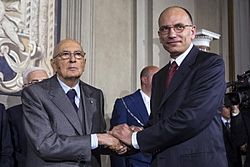
After his re-election, Napolitano immediately began consultations with the chairmen of the Chamber of Deputies, Senate, and political forces after the failure of the previous attempt with Bersani after the inconclusive 2013 Italian general election, and the establishment of a panel of experts by Napolitano himself (dubbed as wise men by the press) in order to outline priorities and formulate an agenda to deal with the persistent economic hardship and growing unemployment.
On 24 April, Napolitano gave to the vice-secretary of the centre-left Democratic Party, Enrico Letta, the task of forming a government, having determined that Bersani, leader of the winning coalition Italy Common Good, could not form a government because it did not have a majority in the Senate. On 27 April, Letta formally accepted the task of leading a grand coalition government, with support from the Democratic Party, of which he remained deputy secretary, the centre-right People of Freedom, and the centrist Civic Choice, and subsequently listed the members of the Letta Cabinet. The government he formed became the first in the history of the Italian Republic to include representatives of all the major candidate-coalitions that had competed in the election. His close relationship with his uncle Gianni Letta, one of Berlusconi's most trusted advisors, was perceived as a way of overcoming the bitter hostility between the two opposing camps. Letta appointed Angelino Alfano, secretary of the People of Freedom, as his Deputy Prime Minister of Italy. Letta was formally sworn-in as Prime Minister on 28 April; during the ceremony, a man fired shots outside Palazzo Chigi and wounded two Carabinieri.
Renzi Cabinet
In the 2013 Democratic Party leadership election, Matteo Renzi, the young mayor of Florence, was elected with 68% of the popular vote, compared to 18% for Gianni Cuperlo, and 14% for Giuseppe Civati. He became the new secretary of the Democratic Party and the centre-left's prospective candidate for Prime Minister. His victory was welcomed by Letta, who had been the vice-secretary of the party under Bersani's leadership.
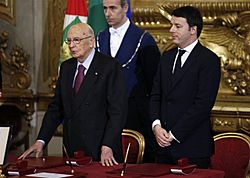
In an earlier speech, Renzi had paid tribute to Letta, saying that he was not intended to put him "on trial". Without directly proposing himself as the next Prime Minister, he said the Eurozone's third-largest economy urgently needed "a new phase" and "radical programme" to push through badly-needed reforms. The motion he put forward made clear "the necessity and urgency of opening a new phase with a new executive". Speaking privately to party leaders, Renzi said that Italy was "at a crossroads" and faced either holding fresh elections or a new government without a return to the polls. On 14 February, Napolitano accepted Letta's resignation from the office of Prime Minister.
Following Letta's resignation, Renzi formally received the task of forming the new Italian government from Napolitano on 17 February. Renzi held several days of talks with party leaders, all of which he broadcast live on the internet, before unveiling his Cabinet on 21 February, which contained members of the Democratic Party, the New Centre-Right, the Union of the Centre, and the Civic Choice. His cabinet became Italy's youngest government to date, with an average age of 47. It was also the first in which the number of female ministers was equal to the number of male ministers, excluding the Prime Minister.
On 22 February, Renzi was formally sworn in as Prime Minister, becoming the fourth Prime Minister in four years and the youngest Prime Minister in the history of Italy, and the Renzi Cabinet was established. On 30 January 2014, the Five Star Movement deposited an impeachment motion, which was later dismissed, accusing Napolitano of harming the Italian constitution, to allow unconstitutional laws and in relation to the State-Mafia Pact.
Resignation
On 9 November 2014, the Italian press reported that Napolitano would step down at the end of the year. The press office of the Quirinal Palace "neither confirmed nor denied" the reports. Napolitano officially resigned on 14 January 2015 after the end of the six-month Italian presidency of the European Union.
Later life and health
After the presidency, he became senator for life after the end of his presidency on 14 January 2015. On 19 January 2015, he joined the For the Autonomies group in the Senate. On 23 and 24 March 2018, he was the provisional president of the Senate as the most senior senator during the election of the new president of the Senate in the Legislature XVIII of Italy. Napolitano had surgery on his aorta in April 2018, and was in the intensive care unit after abdominal surgery in May 2022.
Death
In 2023, Napolitano was hospitalized in Rome shortly after his 98th birthday on 29 June. On 19 September, he was reported to be in critical condition with his health deteriorating, and was taken off life support. He died three days later on 22 September, aged 98.
Electoral history
| Election | House | Constituency | Party | Votes | Result | |
|---|---|---|---|---|---|---|
| 1953 | Chamber of Deputies | Naples–Caserta | PCI | 42,956 | ||
| 1958 | Chamber of Deputies | Naples–Caserta | PCI | 31,969 | ||
| 1968 | Chamber of Deputies | Naples–Caserta | PCI | 78,380 | ||
| 1972 | Chamber of Deputies | Naples–Caserta | PCI | 71,412 | ||
| 1976 | Chamber of Deputies | Naples–Caserta | PCI | 109,776 | ||
| 1979 | Chamber of Deputies | Naples–Caserta | PCI | 89,465 | ||
| 1983 | Chamber of Deputies | Naples–Caserta | PCI | 145,283 | ||
| 1987 | Chamber of Deputies | Naples–Caserta | PCI | 96,853 | ||
| 1989 | European Parliament | Southern Italy | PCI | 358,363 | ||
| 1992 | Chamber of Deputies | Naples–Caserta | PDS | 30,274 | ||
| 1994 | Chamber of Deputies | Naples Fuorigrotta | PDS | 37,214 | ||
| 1999 | European Parliament | Southern Italy | DS | 183,812 | ||
First-past-the-post elections
| 1994 general election (C): Naples — Fuorigrotta | ||||
|---|---|---|---|---|
| Candidate | Coalition | Votes | % | |
| Giorgio Napolitano | Alliance of Progressives | 37,214 | 53.0 | |
| Angelo Tramontano | Pole of Good Government | 25,819 | 36.8 | |
| Vittorio Pellegrino | Pact for Italy | 4,409 | 6.3 | |
| Others | 2,740 | 3.9 | ||
| Total | 70,182 | 100.0 | ||
Presidential elections
| 2006 presidential election (4th ballot) | ||||
|---|---|---|---|---|
| Candidate | Supported by | Votes | % | |
| Giorgio Napolitano | The Union | 543 | 53.8 | |
| Umberto Bossi | LN | 42 | 4.2 | |
| Others | 44 | 4.3 | ||
| Blank or invalid votes | 361 | 35.7 | ||
| Abstentions | 19 | 1.8 | ||
| Total | 1,009 | 100.0 | ||
| 2013 presidential election (6th ballot) | ||||
|---|---|---|---|---|
| Candidate | Supported by | Votes | % | |
| Giorgio Napolitano | PD, PdL, SC, LN | 738 | 73.3 | |
| Stefano Rodotà | M5S, SEL | 217 | 21.5 | |
| Others | 18 | 1.8 | ||
| Blank or invalid votes | 22 | 2.2 | ||
| Abstentions | 10 | 1.0 | ||
| Total | 1,007 | 100.0 | ||
Honours
National honours
 Italy: Head of the Order of Merit of the Italian Republic (15 May 2006 – 14 January 2015)
Italy: Head of the Order of Merit of the Italian Republic (15 May 2006 – 14 January 2015) Italy: Head of the Military Order of Italy (15 May 2006 – 14 January 2015)
Italy: Head of the Military Order of Italy (15 May 2006 – 14 January 2015) Italy: Head of the Order of Merit for Labour (15 May 2006 – 14 January 2015)
Italy: Head of the Order of Merit for Labour (15 May 2006 – 14 January 2015) Italy: Head of the Order of the Star of Italy reformed from Order of the Star of Italian Solidarity (15 May 2006 – 14 January 2015)
Italy: Head of the Order of the Star of Italy reformed from Order of the Star of Italian Solidarity (15 May 2006 – 14 January 2015) Italy: Head of the Order of Vittorio Veneto (15 May 2006 – 14 January 2015)
Italy: Head of the Order of Vittorio Veneto (15 May 2006 – 14 January 2015) Italy: Grand Cross of the Order of Merit of the Italian Republic (28 October 1998), Grand Cross with Collar (15 May 2006)
Italy: Grand Cross of the Order of Merit of the Italian Republic (28 October 1998), Grand Cross with Collar (15 May 2006)
Foreign honours
 Albania: 1st Class of the Order of Skanderbeg (5 March 2014)
Albania: 1st Class of the Order of Skanderbeg (5 March 2014) Austria: Grand Star of the Decoration of Honour for Services to the Republic of Austria (26 June 2007)
Austria: Grand Star of the Decoration of Honour for Services to the Republic of Austria (26 June 2007) Brazil: Collar of the Order of the Southern Cross (10 November 2008)
Brazil: Collar of the Order of the Southern Cross (10 November 2008) Bulgaria: Grand Cross of the Order of the Stara Planina (25 February 2009)
Bulgaria: Grand Cross of the Order of the Stara Planina (25 February 2009) Chile: Collar of the Order of Merit (15 October 2007)
Chile: Collar of the Order of Merit (15 October 2007) Croatia: Grand Cross of the Grand Order of King Tomislav (14 July 2011)
Croatia: Grand Cross of the Grand Order of King Tomislav (14 July 2011) Finland: Grand cross with Collar of the Order of the White Rose (9 September 2008)
Finland: Grand cross with Collar of the Order of the White Rose (9 September 2008) France: Grand Cross of the Order of the Legion of Honour (21 November 2012)
France: Grand Cross of the Order of the Legion of Honour (21 November 2012) Germany: Grand Cross Special Class of the Order of Merit of the Federal Republic of Germany (28 February 2013)
Germany: Grand Cross Special Class of the Order of Merit of the Federal Republic of Germany (28 February 2013) Ghana: Companion of the Order of the Star of Ghana ( 16 October 2006)
Ghana: Companion of the Order of the Star of Ghana ( 16 October 2006) Greece: Grand cross of the Order of the Redeemer (23 September 2008)
Greece: Grand cross of the Order of the Redeemer (23 September 2008) Greece: Recipient of the Medal in Gold of the Parliament Ellenic (23 September 2008)
Greece: Recipient of the Medal in Gold of the Parliament Ellenic (23 September 2008) Israel President's Medal (9 June 2014)
Israel President's Medal (9 June 2014) Jordan: Knight Grand Cordon with Collar of the Order of al-Hussein bin Ali (20 October 2009)
Jordan: Knight Grand Cordon with Collar of the Order of al-Hussein bin Ali (20 October 2009) Kuwait: Collar of the Order of Mubarak the Great (3 May 2010)
Kuwait: Collar of the Order of Mubarak the Great (3 May 2010) Lebanon: Member Extraordinary Grade of the Order of Merit (30 October 2008)
Lebanon: Member Extraordinary Grade of the Order of Merit (30 October 2008) Lithuania: Commander of the Order of Merit (21 April 2004)
Lithuania: Commander of the Order of Merit (21 April 2004) Luxembourg: Knight Grand Cross of the Order of the Gold Lion of the House of Nassau ( 2 February 2009)
Luxembourg: Knight Grand Cross of the Order of the Gold Lion of the House of Nassau ( 2 February 2009) Malta: Honorary Companions of Honour with Collar of the National Order of Merit (30 June 2010)
Malta: Honorary Companions of Honour with Collar of the National Order of Merit (30 June 2010) Netherlands: Grand Cross of the Order of the Netherlands Lion ( 23 October 2012)
Netherlands: Grand Cross of the Order of the Netherlands Lion ( 23 October 2012) Palestine: Grand Cross of the Order of the Star of Palestine (17 October 2013)
Palestine: Grand Cross of the Order of the Star of Palestine (17 October 2013) Poland: Grand cross of the Order of the White Eagle (11 June 2012)
Poland: Grand cross of the Order of the White Eagle (11 June 2012) Qatar: Collar of the Collar of the Independence (13 November 2007)
Qatar: Collar of the Collar of the Independence (13 November 2007) Romania: Collar of the Order of the Star of Romania (15 September 2011)
Romania: Collar of the Order of the Star of Romania (15 September 2011) San Marino: Collar of the Order of San Marino (13 June 2014)
San Marino: Collar of the Order of San Marino (13 June 2014) Saudi Arabia: Collar of the Order of King Abdulaziz (5 November 2007)
Saudi Arabia: Collar of the Order of King Abdulaziz (5 November 2007) Slovakia: Grand Cross of the Order of the White Double Cross ( 27 February 2007)
Slovakia: Grand Cross of the Order of the White Double Cross ( 27 February 2007) Slovenia: Member of the Order for Exceptional Merits (17 January 2011)
Slovenia: Member of the Order for Exceptional Merits (17 January 2011) South Korea: Recipient of the Grand Order of Mugunghwa (14 September 2009)
South Korea: Recipient of the Grand Order of Mugunghwa (14 September 2009) Sovereign Military Order of Malta: Collar of the Order pro Merito Melitensi (6 November 2008)
Sovereign Military Order of Malta: Collar of the Order pro Merito Melitensi (6 November 2008) Spain: Grand Cross of the Order of Isabella the Catholic (26 September 1998)
Spain: Grand Cross of the Order of Isabella the Catholic (26 September 1998) Sweden: Knight of the Royal Order of the Seraphim (13 March 2009)
Sweden: Knight of the Royal Order of the Seraphim (13 March 2009) Syria: Member 1st Class of the Order of Umayyad (18 March 2010)
Syria: Member 1st Class of the Order of Umayyad (18 March 2010) Turkey: First Class of the Order of the State of Republic of Turkey (26 November 2009)
Turkey: First Class of the Order of the State of Republic of Turkey (26 November 2009) Vatican City: Knight with the Collar Order of Pius IX (November 2006)
Vatican City: Knight with the Collar Order of Pius IX (November 2006)- Dan David Prize: To Mr. Giorgio Napolitano, President of the Italian Republic, for his dedication to the cause of Parliamentary democracy, thereby contributing to a strengthening of democratic values and institutions in Italy and Europe; and for his courage and intellectual integrity which have been crucial in healing the wounds of the Cold War in Europe, as well as the scars left in Italy in the wake of fascism.
- Napolitano received Medaglia Teresiana at University of Pavia in 2009.
See also
 In Spanish: Giorgio Napolitano para niños
In Spanish: Giorgio Napolitano para niños



